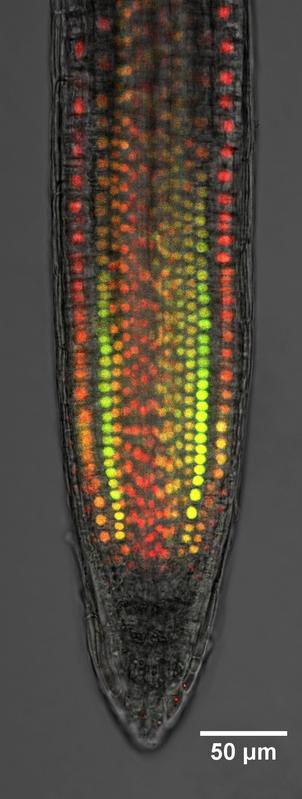New mechanism for the plant hormone auxin discovered

A growing root observed by the research team. Colors are caused by a fluorescent auxin reporter in the nuclei of the cells. Red indicates high amounts of auxin, green indicates low amounts. Matouš Glanc
When the seed of a plant germinates, its root needs to quickly establish the direction of gravity and bend to grow deeper inside the soil, where it can anchor itself, and find water and nutrients. In order to bend, cell growth is allowed to continue on one side of the root while being inhibited on the other.
This inhibition was known to be triggered by the hormone auxin and to happen very quickly, but the exact reaction times were difficult to measure. Using an innovative setup, the researchers could now measure the time roots need to react to changes in the auxin concentration precisely. They concluded that the extremely rapid adaption of growth rate was far too fast to be explained by the gene transcription mechanism, and therefore must involve a correspondingly rapid perception mechanism.
New branch in an old pathway
But the new mechanism is not entirely unknown. Components of the well-studied pathway, the TIR1 receptor, are needed for the newly discovered mechanism. “With our experimental setup, we proved that the signaling is indeed non-transcriptional, but we have seen that components of the original transcriptional pathway are needed,” explains Jiří Friml, Professor at IST Austria and leader of the research group. “This means that we are not looking at an entirely new pathway but at a new branch of the canonical pathway,” he adds.
With a flipped-over microscope and liquid-filled microchannels
With a microscope that was flipped on its side—a method that was developed previously by the same research group and that led to the production of a breathtaking video of growing roots that won last year’s “Nikon Small World in Motion Competition” (see link)—the team was able to observe the roots grow in their natural orientation. But measuring the reaction time required further development of the technique: they needed to be able to quickly change the solution the roots grow in.
“Normally, people would apply the auxin and then mount the sample to the microscope, but with this method, they would lose precious seconds or even minutes—and exactly those first few minutes are the ones that were essential for this study,” explains Matyáš Fendrych, leading author of the study, former postdoc in Jiří Friml’s group and now assistant professor at the Charles University in Prague. The solution found by the team was to let the roots grow in microscopic channels filled with the desired liquid. “This allowed us to change the auxin concentration and immediately measure the root’s reaction,” he adds.
Original publication:
Matyáš Fendrych, et al: “Rapid and reversible root growth inhibition by TIR1 auxin signaling”, nature plant, DOI: 10.1038/s41477-018-0190-1
IST Austria
The Institute of Science and Technology (IST Austria) is a PhD-granting research institution located in Klosterneuburg, 18 km from the center of Vienna, Austria. Inaugurated in 2009, the Institute is dedicated to basic research in the natural and mathematical sciences. IST Austria employs professors on a tenure-track system, postdoctoral fellows, and doctoral students.
While dedicated to the principle of curiosity-driven research, the Institute owns the rights to all scientific discoveries and is committed to promote their use. The first president of IST Austria is Thomas A. Henzinger, a leading computer scientist and former professor at the University of California in Berkeley, USA, and the EPFL in Lausanne, Switzerland. The graduate school of IST Austria offers fully-funded PhD positions to highly qualified candidates with a bachelor's or master's degree in biology, neuroscience, mathematics, computer science, physics, and related areas. http://www.ist.ac.at
http://ist.ac.at/research/research-groups/friml-group/ Research group of Prof Friml
https://www.nikonsmallworld.com/news/timelapse-of-dancing-plant-root-wins-2017-n… Winner of Nikon's Small World in Motion Competition
Media Contact
All latest news from the category: Life Sciences and Chemistry
Articles and reports from the Life Sciences and chemistry area deal with applied and basic research into modern biology, chemistry and human medicine.
Valuable information can be found on a range of life sciences fields including bacteriology, biochemistry, bionics, bioinformatics, biophysics, biotechnology, genetics, geobotany, human biology, marine biology, microbiology, molecular biology, cellular biology, zoology, bioinorganic chemistry, microchemistry and environmental chemistry.
Newest articles

High-energy-density aqueous battery based on halogen multi-electron transfer
Traditional non-aqueous lithium-ion batteries have a high energy density, but their safety is compromised due to the flammable organic electrolytes they utilize. Aqueous batteries use water as the solvent for…

First-ever combined heart pump and pig kidney transplant
…gives new hope to patient with terminal illness. Surgeons at NYU Langone Health performed the first-ever combined mechanical heart pump and gene-edited pig kidney transplant surgery in a 54-year-old woman…

Biophysics: Testing how well biomarkers work
LMU researchers have developed a method to determine how reliably target proteins can be labeled using super-resolution fluorescence microscopy. Modern microscopy techniques make it possible to examine the inner workings…





















